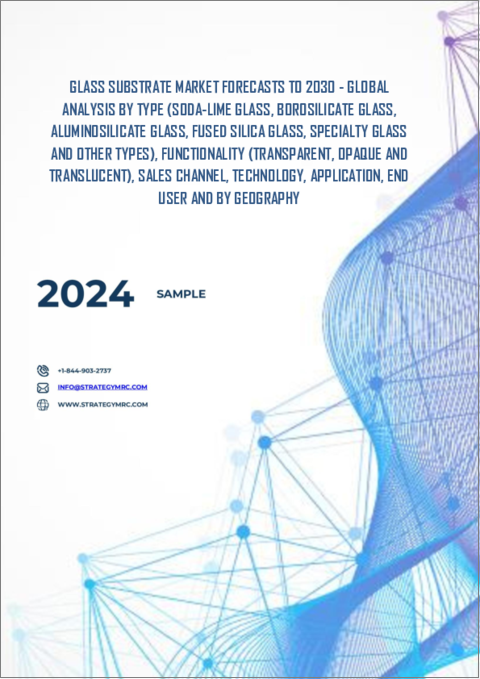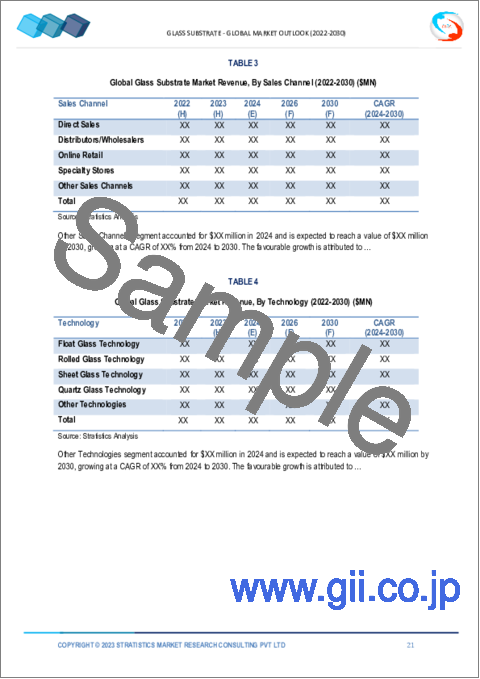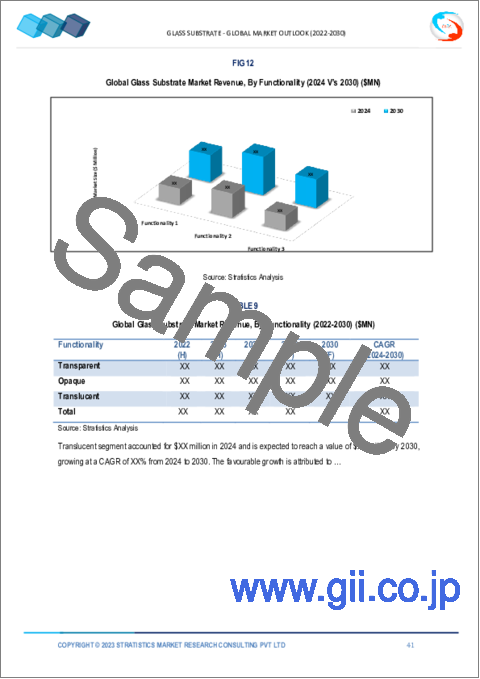|
|
市場調査レポート
商品コード
1453985
ガラス基板市場の2030年までの予測: タイプ別、機能別、販売チャネル別、技術別、用途別、エンドユーザー別、地域別の世界分析Glass Substrate Market Forecasts to 2030 - Global Analysis By Type, Functionality, Sales Channel, Technology, Application, End User and By Geography |
||||||
カスタマイズ可能
|
|||||||
| ガラス基板市場の2030年までの予測: タイプ別、機能別、販売チャネル別、技術別、用途別、エンドユーザー別、地域別の世界分析 |
|
出版日: 2024年03月03日
発行: Stratistics Market Research Consulting
ページ情報: 英文 200+ Pages
納期: 2~3営業日
|
全表示
- 概要
- 図表
- 目次
Stratistics MRCによると、ガラス基板の世界市場は2023年に75億1,000万米ドルを占め、予測期間中のCAGRは5.5%で、2030年には109億2,000万米ドルに達すると予測されています。
ガラス基板は、電子部品のベースとして使用されるガラスから作られた平らで硬い材料です。ガラス基板は構造的な支持を提供し、様々な材料の薄膜を成膜するための土台となります。ガラス基板は、その透明性、平滑性、熱特性から選ばれます。ガラス基板の特性は、最終製品の性能や耐久性に大きく影響します。
インド・ブランド・エクイティ財団(IBEF)によると、同国のヘルスケア産業は2022年までに3,720億米ドルに達すると予想されています。
ソーラーパネル需要の急増
再生可能エネルギーへの取り組みが世界の盛り上がりを見せる中、ソーラーパネル用の高品質ガラス基板のニーズが大幅に高まっています。ガラス基板はソーラーパネル製造に不可欠な部品であり、効率的なエネルギー変換のための耐久性と透明性を提供します。このような需要の高まりは、薄型化や高効率設計など、ガラス基板技術の進歩につながり、市場の成長をさらに後押ししています。持続可能なエネルギー源に向けた追い風を受けて、ガラス基板の需要は上昇基調を続けると予想されます。
原材料価格の変動
ガラス基板業界における原材料価格の変動は、主にサプライチェーンの混乱、エネルギーコストの変化、為替変動などの要因に影響されます。これらの変動はメーカーの生産コスト上昇につながり、収益性や価格戦略に影響を与えます。さらに、生産コストの上昇は最終的に消費者に転嫁される可能性があり、ガラス基板の需要を減退させ、市場全体の成長を阻害する可能性があります。
自動車産業の拡大
自動車メーカーは、ヘッドアップディスプレイ、タッチスクリーン、ADAS(先進運転支援システム)など、より高度な技術を自動車に搭載しており、これにより高品質ガラス基板の需要が増加しています。これらの基板は、車載ディスプレイやセンサーの製造に不可欠な部品であり、耐久性、透明性、機能性を提供します。その結果、自動車産業の拡大がガラス基板に対する機会と需要の拡大につながり、市場の成長を牽引しています。
代替品との激しい競合
プラスチック基板や有機材料などの代替材料は、柔軟性、軽量性、低コストなどの利点を提供します。代替材料が利用可能になると、一部の消費者はガラス以外の選択肢を選ぶようになり、その結果、特定の用途におけるガラス基板の需要全体が減少する可能性があります。その結果、市場は製品への適応と差別化を迫られることになります。メーカー各社は市場シェアを維持するために絶え間ない技術革新に取り組まなければならないため、このような競合は市場の成長を妨げる可能性があります。
COVID-19の影響
COVID-19の大流行はガラス基板市場に大きな影響を与えました。当初、市場はサプライチェーンの中断、労働力不足、エレクトロニクスや自動車などの産業からの需要減少による混乱に直面しました。封鎖措置や経済の不確実性がプロジェクトの遅延やキャンセルにつながり、ガラス基板メーカーに影響を与えました。しかし、経済が徐々に再開し、遠隔地での仕事が急増したため、電子機器の需要が回復し、ディスプレイや半導体などの用途でガラス基板のニーズが高まりました。
予測期間中、石英ガラスセグメントが最大となる見込み
溶融シリカガラスセグメントは有利な成長を遂げると推定されます。二酸化ケイ素の高純度形態である石英ガラスは、その卓越した光学的・熱的特性により、様々な産業で重要な基板としての役割を果たしています。溶融と冷却を含む特殊な製造工程を経て生産されるこのガラスは、低熱膨張率、広いスペクトルにわたる高い透明性、温度変動に対する優れた耐性を誇っています。その純度と安定性は、宇宙探査や高エネルギー物理学実験のような要求の厳しい環境に適しています。
予測期間中、エレクトロニクス分野のCAGRが最も高くなると予想されています。
エレクトロニクス分野は、予測期間中に最も高いCAGR成長が見込まれます。ガラス基板は、半導体材料の成膜や複雑な電子回路の作成に安定した平坦面を提供します。ガラス基板は優れた熱安定性と寸法安定性を備えており、デバイスの性能を長期にわたって維持するために極めて重要です。さらに、ガラス基板は高解像度のイメージングを可能にし、電子機器の耐久性を確保し、その寿命と信頼性を高めます。ガラス技術の進歩に伴い、より薄くフレキシブルな基板が開発され、電子デバイスの設計と機能性に新たな可能性をもたらしています。
最もシェアの高い地域
アジア太平洋地域は、急速な工業化、都市化、技術進歩に牽引され、ガラス基板市場の主要プレーヤーとなっています。中国、日本、韓国、台湾のような国々は、エレクトロニクス産業や自動車産業が確立されており、市場成長に大きく貢献しています。この地域は、熟練した労働力、堅牢なインフラ、製造業への技術革新と投資を促進する有利な政府政策の恩恵を受けています。民生用電子機器の需要拡大がアジア太平洋地域の高品質ガラス基板需要をさらに押し上げ、業界関係者にとって有利な市場となっています。
CAGRが最も高い地域:
北米は、大手エレクトロニクスメーカーや自動車メーカーの存在により、予測期間中最も高いCAGRを示すと予測されています。この地域は、整備されたインフラ、熟練した労働力、研究開発への多額の投資などの恩恵を受けています。同市場の主要プレーヤーには米国とカナダが含まれ、先進的な製造プロセスを活用しています。さらに、スマートデバイスや電気自動車の採用が増加していることも、北米地域の市場成長をさらに刺激しています。
無料カスタマイズサービス:
本レポートをご購読のお客様には、以下の無料カスタマイズオプションのいずれかをご利用いただけます:
- 企業プロファイル
- 追加市場プレイヤーの包括的プロファイリング(3社まで)
- 主要企業のSWOT分析(3社まで)
- 地域セグメンテーション
- 顧客の関心に応じた主要国の市場推計・予測・CAGR(注:フィージビリティチェックによる)
- 競合ベンチマーキング
- 製品ポートフォリオ、地理的プレゼンス、戦略的提携に基づく主要企業のベンチマーキング
目次
第1章 エグゼクティブサマリー
第2章 序文
- 概要
- ステークホルダー
- 調査範囲
- 調査手法
- データマイニング
- データ分析
- データ検証
- 調査アプローチ
- 調査ソース
- 1次調査ソース
- 2次調査ソース
- 前提条件
第3章 市場動向分析
- 促進要因
- 抑制要因
- 機会
- 脅威
- 技術分析
- 用途分析
- エンドユーザー分析
- 新興市場
- 新型コロナウイルス感染症(COVID-19)の影響
第4章 ポーターのファイブフォース分析
- 供給企業の交渉力
- 買い手の交渉力
- 代替品の脅威
- 新規参入業者の脅威
- 競争企業間の敵対関係
第5章 世界のガラス基板市場:種類別
- ソーダライムガラス
- ホウケイ酸ガラス
- アルミノケイ酸ガラス
- 溶融石英ガラス
- 特殊ガラス
- その他のタイプ
第6章 世界のガラス基板市場:機能別
- 透明
- 不透明
- 半透明
第7章 世界のガラス基板市場:販売チャネル別
- 直販
- 代理店・卸売業者
- オンライン小売
- 専門店
- その他の販売チャネル
第8章 世界のガラス基板市場:技術別
- フロートガラス技術
- ロールガラス技術
- 板ガラス技術
- 石英ガラス技術
- その他の技術
第9章 世界のガラス基板市場:用途別
- フラットパネルディスプレイ
- 太陽電池
- 半導体基板
- 建築用ガラス
- 光学デバイス
- その他の用途
第10章 世界のガラス基板市場:エンドユーザー別
- エレクトロニクス
- 自動車
- ヘルスケア
- 航空宇宙と防衛
- 建設
- その他のエンドユーザー
第11章 世界のガラス基板市場:地域別
- 北米
- 米国
- カナダ
- メキシコ
- 欧州
- ドイツ
- 英国
- イタリア
- フランス
- スペイン
- その他欧州
- アジア太平洋地域
- 日本
- 中国
- インド
- オーストラリア
- ニュージーランド
- 韓国
- その他アジア太平洋地域
- 南米
- アルゼンチン
- ブラジル
- チリ
- その他南米
- 中東とアフリカ
- サウジアラビア
- アラブ首長国連邦
- カタール
- 南アフリカ
- その他中東とアフリカ
第12章 主な発展
- 契約、パートナーシップ、コラボレーション、合弁事業
- 買収と合併
- 新製品の発売
- 事業拡大
- その他の主要戦略
第13章 企業プロファイル
- Corning Incorporated
- Asahi Glass Co. Limited
- Nippon Electric Glass Corporation
- SCHOTT AG
- Guardian Industries
- Intel Corporation
- IRICO Group
- Plan Optik AG
- AvanStrate Inc.
- OHARA Inc.
- Abrisa Technologies
- Saint-Gobain S.A.
- Taiwan Glass Corporation
- LG Chem Limited
- Tecnisco Limited
List of Tables
- Table 1 Global Glass Substrate Market Outlook, By Region (2021-2030) ($MN)
- Table 2 Global Glass Substrate Market Outlook, By Type (2021-2030) ($MN)
- Table 3 Global Glass Substrate Market Outlook, By Soda-Lime Glass (2021-2030) ($MN)
- Table 4 Global Glass Substrate Market Outlook, By Borosilicate Glass (2021-2030) ($MN)
- Table 5 Global Glass Substrate Market Outlook, By Aluminosilicate Glass (2021-2030) ($MN)
- Table 6 Global Glass Substrate Market Outlook, By Fused Silica Glass (2021-2030) ($MN)
- Table 7 Global Glass Substrate Market Outlook, By Specialty Glass (2021-2030) ($MN)
- Table 8 Global Glass Substrate Market Outlook, By Other Types (2021-2030) ($MN)
- Table 9 Global Glass Substrate Market Outlook, By Functionality (2021-2030) ($MN)
- Table 10 Global Glass Substrate Market Outlook, By Transparent (2021-2030) ($MN)
- Table 11 Global Glass Substrate Market Outlook, By Opaque (2021-2030) ($MN)
- Table 12 Global Glass Substrate Market Outlook, By Translucent (2021-2030) ($MN)
- Table 13 Global Glass Substrate Market Outlook, By Sales Channel (2021-2030) ($MN)
- Table 14 Global Glass Substrate Market Outlook, By Direct Sales (2021-2030) ($MN)
- Table 15 Global Glass Substrate Market Outlook, By Distributors/Wholesalers (2021-2030) ($MN)
- Table 16 Global Glass Substrate Market Outlook, By Online Retail (2021-2030) ($MN)
- Table 17 Global Glass Substrate Market Outlook, By Specialty Stores (2021-2030) ($MN)
- Table 18 Global Glass Substrate Market Outlook, By Other Sales Channels (2021-2030) ($MN)
- Table 19 Global Glass Substrate Market Outlook, By Technology (2021-2030) ($MN)
- Table 20 Global Glass Substrate Market Outlook, By Float Glass Technology (2021-2030) ($MN)
- Table 21 Global Glass Substrate Market Outlook, By Rolled Glass Technology (2021-2030) ($MN)
- Table 22 Global Glass Substrate Market Outlook, By Sheet Glass Technology (2021-2030) ($MN)
- Table 23 Global Glass Substrate Market Outlook, By Quartz Glass Technology (2021-2030) ($MN)
- Table 24 Global Glass Substrate Market Outlook, By Other Technologies (2021-2030) ($MN)
- Table 25 Global Glass Substrate Market Outlook, By Application (2021-2030) ($MN)
- Table 26 Global Glass Substrate Market Outlook, By Flat Panel Displays (2021-2030) ($MN)
- Table 27 Global Glass Substrate Market Outlook, By Photovoltaic Cells (2021-2030) ($MN)
- Table 28 Global Glass Substrate Market Outlook, By Semiconductor Substrates (2021-2030) ($MN)
- Table 29 Global Glass Substrate Market Outlook, By Architectural Glass (2021-2030) ($MN)
- Table 30 Global Glass Substrate Market Outlook, By Optical Devices (2021-2030) ($MN)
- Table 31 Global Glass Substrate Market Outlook, By Other Applications (2021-2030) ($MN)
- Table 32 Global Glass Substrate Market Outlook, By End User (2021-2030) ($MN)
- Table 33 Global Glass Substrate Market Outlook, By Electronics (2021-2030) ($MN)
- Table 34 Global Glass Substrate Market Outlook, By Automotive (2021-2030) ($MN)
- Table 35 Global Glass Substrate Market Outlook, By Healthcare (2021-2030) ($MN)
- Table 36 Global Glass Substrate Market Outlook, By Aerospace & Defense (2021-2030) ($MN)
- Table 37 Global Glass Substrate Market Outlook, By Construction (2021-2030) ($MN)
- Table 38 Global Glass Substrate Market Outlook, By Other End Users (2021-2030) ($MN)
Note: Tables for North America, Europe, APAC, South America, and Middle East & Africa Regions are also represented in the same manner as above.
According to Stratistics MRC, the Global Glass Substrate Market is accounted for $7.51 billion in 2023 and is expected to reach $10.92 billion by 2030 growing at a CAGR of 5.5% during the forecast period. A glass substrate is a flat, rigid material made from glass used as a base for electronic components. It provides structural support and serves as a foundation for depositing thin films of various materials. Glass substrates are chosen for their transparency, smoothness, and thermal properties. The properties of the glass substrate significantly influence the performance and durability of the final product.
According to India Brand Equity Foundation (IBEF), the healthcare industry in the country is expected to reach by USD 372 billion by 2022.
Market Dynamics:
Driver:
Surging demand for solar panels
As renewable energy initiatives continue to gain traction globally, the need for high-quality glass substrates for solar panels has increased substantially. Glass substrates are essential components in solar panel manufacturing, providing durability and transparency for efficient energy conversion. This rising demand has led to advancements in glass substrate technology, including thinner and more efficient designs, further driving growth in the market. With the push towards sustainable energy sources, the demand for glass substrates is expected to continue its upward trajectory.
Restraint:
Fluctuating raw material prices
Fluctuating raw material prices in the glass substrate industry are primarily influenced by factors such as supply chain disruptions, changes in energy costs, and currency fluctuations. These fluctuations can lead to increased production costs for manufacturers, affecting their profitability and pricing strategies. Additionally, higher production costs may ultimately be passed on to consumers, potentially dampening demand for glass substrates and hindering overall market growth.
Opportunity:
Expansion of the automotive industry
The vehicle manufacturers incorporate more advanced technologies into their vehicles, such as heads-up displays, touch screens, and advanced driver assistance systems (ADAS), which has increased the demand for high-quality glass substrates. These substrates are essential components in the production of automotive displays and sensors, providing durability, clarity, and functionality. As a result, the expansion of the automotive industry has led to greater opportunities and demand for glass substrates, driving growth in the market.
Threat:
Intense competition from alternatives
Alternatives such as plastic substrates and organic materials offer advantages such as flexibility, lightweight, and lower cost. The availability of alternative materials may lead some consumers to choose non-glass options, thereby reducing overall demand for glass substrates in certain applications. As a result, the market faces pressure to adapt and differentiate its offerings. This competition can hamper market growth as manufacturers must continually innovate to maintain market share.
Covid-19 Impact
The covid-19 pandemic significantly impacted the glass substrate market. Initially, the market faced disruptions due to supply chain interruptions, workforce shortages, and decreased demand from industries like electronics and automotive. Lockdown measures and economic uncertainties led to project delays and cancellations, affecting glass substrate manufacturers. However, as economies gradually reopened and remote work surged, there was a rebound in demand for electronic devices, driving the need for glass substrates in applications like displays and semiconductors.
The fused silica glass segment is expected to be the largest during the forecast period
The fused silica glass segment is estimated to have a lucrative growth. Fused silica glass, a high-purity form of silicon dioxide, serves as a crucial substrate in various industries due to its exceptional optical and thermal properties. Produced through a specialized manufacturing process involving melting and cooling, it boasts low thermal expansion, high transparency across a wide spectrum, and excellent resistance to temperature fluctuations. Its purity and stability make it suitable for demanding environments like space exploration and high-energy physics experiments.
The electronics segment is expected to have the highest CAGR during the forecast period
The electronics segment is anticipated to witness the highest CAGR growth during the forecast period. Glass substrates provide a stable, flat surface for depositing semiconductor materials and creating intricate electronic circuits. They offer excellent thermal and dimensional stability, crucial for maintaining device performance over time. Furthermore, glass substrates enable high-resolution imaging and ensure durability in electronic devices, enhancing their longevity and reliability. With advancements in glass technology, thinner and more flexible substrates are being developed, enabling new possibilities in electronic device design and functionality.
Region with largest share:
The Asia-Pacific region is a key player in the glass substrate market, driven by rapid industrialization, urbanization, and technological advancements. Countries like China, Japan, South Korea, and Taiwan are major contributors to market growth, with established electronics and automotive industries. The region benefits from a skilled workforce, robust infrastructure, and favourable government policies promoting innovation and investment in manufacturing. The growing demand for consumer electronics further fuels the demand for high-quality glass substrates in the Asia-Pacific region, making it a lucrative market for industry players.
Region with highest CAGR:
North America is projected to have the highest CAGR over the forecast period, owing to the presence of leading electronics and automotive manufacturers. The region benefits from a well-developed infrastructure, skilled workforce, and significant investments in research and development. Key players in the market include the United States and Canada, where companies leverage advanced manufacturing processes. Additionally, increasing adoption of smart devices and electric vehicles further stimulates market growth in the North American region.
Key players in the market
Some of the key players profiled in the Glass Substrate Market include Corning Incorporated, Asahi Glass Co. Limited, Nippon Electric Glass Corporation, SCHOTT AG, Guardian Industries, Intel Corporation, IRICO Group, Plan Optik AG, AvanStrate Inc., OHARA Inc., Abrisa Technologies, Saint-Gobain S.A., Taiwan Glass Corporation, LG Chem Limited and Tecnisco Limited.
Key Developments:
In September 2023, Intel has launched a novel glass substrate designed for "next-generation advanced packaging. The glass substrates are designed to enable the scaling of transistors in a package and advance Moore's Law.
In June 2023, Saint-Gobain India has unveiled its first production of a new glass with a remarkably low carbon footprint. This new glass substrate will retain the same level of technical, quality, and aesthetic performance as regular glass. It will soon be integrated as an option in the energy-efficient glass portfolio of Saint-Gobain Glass India, significantly contributing to the reduction of embodied carbon in buildings while enhancing operational energy efficiency.
Types Covered:
- Soda-Lime Glass
- Borosilicate Glass
- Aluminosilicate Glass
- Fused Silica Glass
- Specialty Glass
- Other Types
Functionalities Covered:
- Transparent
- Opaque
- Translucent
Sales Channels Covered:
- Direct Sales
- Distributors/Wholesalers
- Online Retail
- Specialty Stores
- Other Sales Channels
Technologies Covered:
- Float Glass Technology
- Rolled Glass Technology
- Sheet Glass Technology
- Quartz Glass Technology
- Other Technologies
Applications Covered:
- Flat Panel Displays
- Photovoltaic Cells
- Semiconductor Substrates
- Architectural Glass
- Optical Devices
- Other Applications
End Users Covered:
- Electronics
- Automotive
- Healthcare
- Aerospace & Defense
- Construction
- Other End Users
Regions Covered:
- North America
- US
- Canada
- Mexico
- Europe
- Germany
- UK
- Italy
- France
- Spain
- Rest of Europe
- Asia Pacific
- Japan
- China
- India
- Australia
- New Zealand
- South Korea
- Rest of Asia Pacific
- South America
- Argentina
- Brazil
- Chile
- Rest of South America
- Middle East & Africa
- Saudi Arabia
- UAE
- Qatar
- South Africa
- Rest of Middle East & Africa
What our report offers:
- Market share assessments for the regional and country-level segments
- Strategic recommendations for the new entrants
- Covers Market data for the years 2021, 2022, 2023, 2026, and 2030
- Market Trends (Drivers, Constraints, Opportunities, Threats, Challenges, Investment Opportunities, and recommendations)
- Strategic recommendations in key business segments based on the market estimations
- Competitive landscaping mapping the key common trends
- Company profiling with detailed strategies, financials, and recent developments
- Supply chain trends mapping the latest technological advancements
Free Customization Offerings:
All the customers of this report will be entitled to receive one of the following free customization options:
- Company Profiling
- Comprehensive profiling of additional market players (up to 3)
- SWOT Analysis of key players (up to 3)
- Regional Segmentation
- Market estimations, Forecasts and CAGR of any prominent country as per the client's interest (Note: Depends on feasibility check)
- Competitive Benchmarking
- Benchmarking of key players based on product portfolio, geographical presence, and strategic alliances
Table of Contents
1 Executive Summary
2 Preface
- 2.1 Abstract
- 2.2 Stake Holders
- 2.3 Research Scope
- 2.4 Research Methodology
- 2.4.1 Data Mining
- 2.4.2 Data Analysis
- 2.4.3 Data Validation
- 2.4.4 Research Approach
- 2.5 Research Sources
- 2.5.1 Primary Research Sources
- 2.5.2 Secondary Research Sources
- 2.5.3 Assumptions
3 Market Trend Analysis
- 3.1 Introduction
- 3.2 Drivers
- 3.3 Restraints
- 3.4 Opportunities
- 3.5 Threats
- 3.6 Technology Analysis
- 3.7 Application Analysis
- 3.8 End User Analysis
- 3.9 Emerging Markets
- 3.10 Impact of Covid-19
4 Porters Five Force Analysis
- 4.1 Bargaining power of suppliers
- 4.2 Bargaining power of buyers
- 4.3 Threat of substitutes
- 4.4 Threat of new entrants
- 4.5 Competitive rivalry
5 Global Glass Substrate Market, By Type
- 5.1 Introduction
- 5.2 Soda-Lime Glass
- 5.3 Borosilicate Glass
- 5.4 Aluminosilicate Glass
- 5.5 Fused Silica Glass
- 5.6 Specialty Glass
- 5.7 Other Types
6 Global Glass Substrate Market, By Functionality
- 6.1 Introduction
- 6.2 Transparent
- 6.3 Opaque
- 6.4 Translucent
7 Global Glass Substrate Market, By Sales Channel
- 7.1 Introduction
- 7.2 Direct Sales
- 7.3 Distributors/Wholesalers
- 7.4 Online Retail
- 7.5 Specialty Stores
- 7.6 Other Sales Channels
8 Global Glass Substrate Market, By Technology
- 8.1 Introduction
- 8.2 Float Glass Technology
- 8.3 Rolled Glass Technology
- 8.4 Sheet Glass Technology
- 8.5 Quartz Glass Technology
- 8.6 Other Technologies
9 Global Glass Substrate Market, By Application
- 9.1 Introduction
- 9.2 Flat Panel Displays
- 9.3 Photovoltaic Cells
- 9.4 Semiconductor Substrates
- 9.5 Architectural Glass
- 9.6 Optical Devices
- 9.7 Other Applications
10 Global Glass Substrate Market, By End User
- 10.1 Introduction
- 10.2 Electronics
- 10.3 Automotive
- 10.4 Healthcare
- 10.5 Aerospace & Defense
- 10.6 Construction
- 10.7 Other End Users
11 Global Glass Substrate Market, By Geography
- 11.1 Introduction
- 11.2 North America
- 11.2.1 US
- 11.2.2 Canada
- 11.2.3 Mexico
- 11.3 Europe
- 11.3.1 Germany
- 11.3.2 UK
- 11.3.3 Italy
- 11.3.4 France
- 11.3.5 Spain
- 11.3.6 Rest of Europe
- 11.4 Asia Pacific
- 11.4.1 Japan
- 11.4.2 China
- 11.4.3 India
- 11.4.4 Australia
- 11.4.5 New Zealand
- 11.4.6 South Korea
- 11.4.7 Rest of Asia Pacific
- 11.5 South America
- 11.5.1 Argentina
- 11.5.2 Brazil
- 11.5.3 Chile
- 11.5.4 Rest of South America
- 11.6 Middle East & Africa
- 11.6.1 Saudi Arabia
- 11.6.2 UAE
- 11.6.3 Qatar
- 11.6.4 South Africa
- 11.6.5 Rest of Middle East & Africa
12 Key Developments
- 12.1 Agreements, Partnerships, Collaborations and Joint Ventures
- 12.2 Acquisitions & Mergers
- 12.3 New Product Launch
- 12.4 Expansions
- 12.5 Other Key Strategies
13 Company Profiling
- 13.1 Corning Incorporated
- 13.2 Asahi Glass Co. Limited
- 13.3 Nippon Electric Glass Corporation
- 13.4 SCHOTT AG
- 13.5 Guardian Industries
- 13.6 Intel Corporation
- 13.7 IRICO Group
- 13.8 Plan Optik AG
- 13.9 AvanStrate Inc.
- 13.10 OHARA Inc.
- 13.11 Abrisa Technologies
- 13.12 Saint-Gobain S.A.
- 13.13 Taiwan Glass Corporation
- 13.14 LG Chem Limited
- 13.15 Tecnisco Limited






